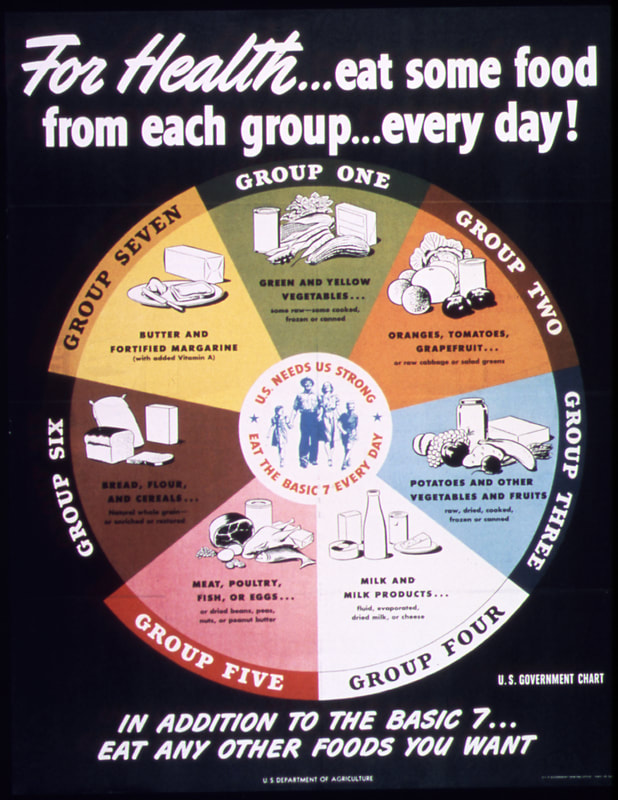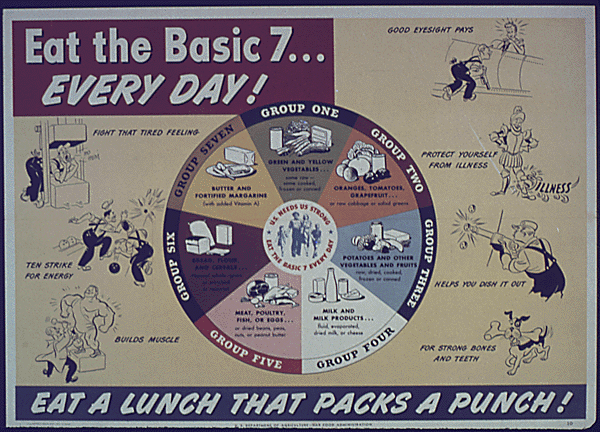|
During the Second World War, new research into nutrition science and the importance of vitamins meant that scientists and government officials alike were looking to increase public awareness about these new discoveries. In particular, emphasis was placed on the importance of keeping the populace healthy, strong, and able to keep up the punishing pace of total war. The Basic 7 was a precursor to the food pyramid and "MyPlate" interpretations of an easy way for Americans to know what healthful foods to eat. In effect from 1943 to 1956, the Basic 7 were replaced with a consolidated Basic 4, and later the food pyramid. Group One: Green and Yellow Vegetables Designed to encourage Vitamin A intake, this group emphasized dark leafy greens and other green and yellow vegetables. These vegetables were recommended to be eaten raw, canned, cooked, or frozen. Although I'm guessing you were supposed to heat the frozen ones first. Night blindness and poor eyesight was a real fear for both soldiers and industrial workers alike and Vitamin A was touted as a preventative against poor eye health. Group Two: Oranges, Tomatoes, Grapefruit This group also included raw cabbage and salad greens, both good sources of Vitamin C, along with oranges, tomatoes, and grapefruit. Vitamin C deficiency was by the 1940s long known as the cause of scurvy. Canned tomatoes and oranges in particular were popular sources, but as this group points out, other foods like raw cabbage and salad greens, especially spinach, also have very high levels of Vitamin C. Group Three: Potatoes and Other Vegetables and Fruits This group was meant largely to round out the vegetables with fiber and carbohydrates. If you haven't noticed by now, the first three groups are all made of fruits and vegetables, as they were plentiful and not rationed during the war. Potatoes in particular were touted during both World Wars as an alternative to bread. Group Four: Milk and Milk Products Long considered the "perfect food," - a balance of fats, protein, and sugars, by the 1940s milk and other dairy products were also recognized as excellent sources of calcium. With the exception of cheese, most dairy products were not rationed during the war and cottage cheese in particular was promoted as a high-protein meat substitute. Group Five: Meat, Poultry, Fish, or Eggs This group also included dried beans, peas, nuts, and peanut butter, and emphasized protein. Meat was quite heavily rationed during the war, so fish, beans, and nuts were often suggested as meat substitutes. Soybeans (called "soya" in the period) were a "new" miracle protein source that never really caught on. At least, not until West Coast hippies were introduced to tofu by Japanese Americans in the 1960s. Group Six: Bread, Flour, and Cereals In the 1940s bread and other cereal products were still the backbone of many American meals. Cold or hot cereal, toast, or pancakes for breakfast, sandwiches for lunch, bread with every dinner - these were the typical meals of most Americans. But while the simple carbohydrates of refined white bread were vaunted before the First World War, by the Second World War nutritionists realized that white flour had been stripped of most of its nutrition with the elimination of the wheat germ. So whole grains, flour, and cereal products were touted for their nutritive value. But, because white flour was so very popular, "enriched" or "restored" cereal products were also allowed. This gave rise to foods like Wonder Bread - so-called because it was "enriched" with a half a dozen vitamins and minerals - something allowed thanks to technological advances in artificial vitamin production. Group Seven: Butter and Fortified Margarine Yes, you read that correctly. Butter was it's own food group during WWII. Seems crazy these days, but this group was also focused on getting Americans adequate supplies of Vitamin A. Today, the Vitamin A found in animal-based foods is called Vitamin A1, or retinol. Vitamin A deficiency includes dry eyes and eventual blindness. So it was an important vitamin to keep people in top working condition. Ironically, a tablespoon of butter only gives you about 11% of your daily recommended intake of Vitamin A, whereas other common WWII ration-relievers like beef liver and the oft-dreaded cod liver oil, provide more than enough Vitamin A per serving. But perhaps because rationing limited fats, officials felt that by putting butter on the Basic 7, they would be relieving some of the monotony of rationed diets. In addition, the more detailed poster below, indicates that eating butter or margarine helps you feel more satisfied or fuller after a meal. Conventional wisdom that has stood the test of time, as fat helps you feel more satiated than just about any other food. By equating butter with fortified margarine, officials also helped remove some of the stigma from margarine, which still held some stigma as poverty food with a whiff of slaughterhouse about it, as originally margarine was made from scrap meat fats, as opposed to the supposedly more wholesome vegetable oils that were common by the 1940s. Of course, we know now that the hydrogenating process to solidify vegetable oils creates trans fats, one of the most harmful fats you can eat. But, like the effects of the atomic bomb, no one really knew that in the 1940s. Altogether, the Basic 7 emphasized nutrients, rather than calories, as later version would come to embrace. The Basic 7 focused on bodily performance, rather than weight loss. "Eat a Lunch That Packs a Punch!" was a common motto from the war and was designed to keep up health, strength, and stamina during mobilization. All images in this blog post are from the National Archives and Records Administration.
If you enjoyed this installment of #WorldWarWednesdays, consider becoming a Food Historian patron on Patreon! Members get to vote for new blog post and podcast topics, get access to my food library, research advice, and more!
0 Comments
Your comment will be posted after it is approved.
Leave a Reply. |
AuthorSarah Wassberg Johnson has an MA in Public History from the University at Albany and studies early 20th century food history. Archives
July 2024
Categories
All
|



 RSS Feed
RSS Feed